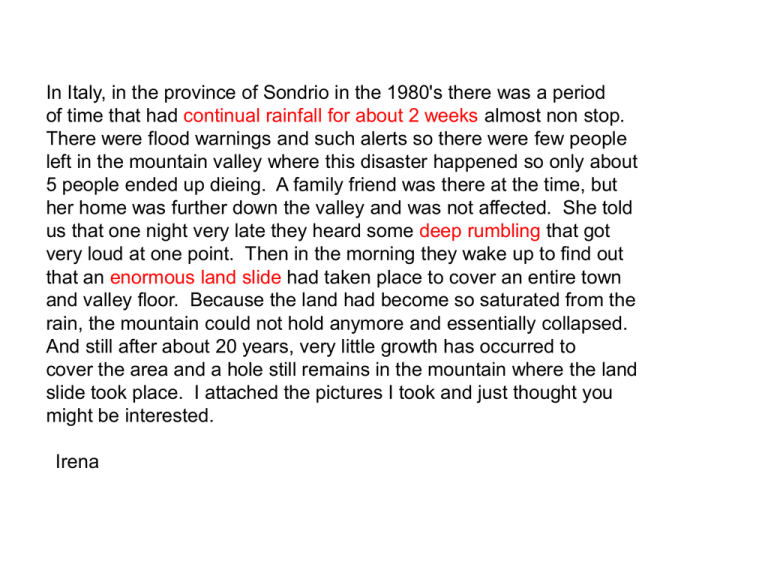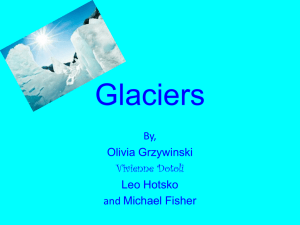Lecture 15: Ice Ages
advertisement

In Italy, in the province of Sondrio in the 1980's there was a period of time that had continual rainfall for about 2 weeks almost non stop. There were flood warnings and such alerts so there were few people left in the mountain valley where this disaster happened so only about 5 people ended up dieing. A family friend was there at the time, but her home was further down the valley and was not affected. She told us that one night very late they heard some deep rumbling that got very loud at one point. Then in the morning they wake up to find out that an enormous land slide had taken place to cover an entire town and valley floor. Because the land had become so saturated from the rain, the mountain could not hold anymore and essentially collapsed. And still after about 20 years, very little growth has occurred to cover the area and a hole still remains in the mountain where the land slide took place. I attached the pictures I took and just thought you might be interested. Irena landslide scar Note little alluvial fan Case Study Case Study Discovery of the Ice Age 1837 Swiss naturalist Louis Agassis speaks at Swiss sachet of Natural Sciences. Replaces talk on fossil fishes with one proposing an 'ice age' in Europe and North America. Louis Agassis Who was President in 1837? QuickTime™ and a TIFF (LZW) decompressor are needed to see this picture. QuickTime™ and a TIFF (LZW) decompressor are needed to see this picture. 170 out of 294 electoral votes Why 1837 ? What Precusory Knowledge was necessary ? What Cultural Factors were important ? First … a photo tour of glaciers and glacial features Glacial flow movies QuickTime™ and a TIFF (LZW) decompressor are needed to see this picture. http://www.swisseduc.ch/glaciers/aletsch-livecam/index-en.html QuickTime™ and a TIFF (LZW) decompressor are needed to see this picture. QuickTime™ and a TIFF (LZW) decompressor are needed to see this picture. Why 1837 ? What Precusory Knowledge was necessary ? What Cultural Factors were important ? 1815, Jean-Pierre Perraudin, Swiss Mountaineer. “Having long ago observed marks and scars occurring on hard rocks which do not weather, I finally decided, after going near the glaciers, that they had been made by the pressure or weight of these masses, at which I find traces as least as far as Champsec. This makes me think that glaciers filled in the past the entire Val de Bagnes, and I am ready to demonstrate this fact to incredulous people by the obvious proof of comparing these marks with those uncovered by glaciers at present.” 1815, Jean De Charpentier, Swiss naturalist. “Although Perraudin extended his glacier only [24 miles beyond its limit to Martigny], because he himself probably had never been beyond that town, and although I agreed with him on the improbability of transporting erratic boulders by water, I nevertheless found his hypothesis so extraordinary and even so extravagant that I considered it as not worth examining or even considering.“ 1821-1833, Ignace Venetz, highway engineer, studies glaciers, characterizes their movements. 1829, De Charpentier systematically characterizes evidence of glaciation. 1834, De Charpentier. Traveling through the valley of Hasli and Lungern, I met on the Brunig road a woodcutter from Meiringen. We talked and walked for a while. As I was examining a large boulder of Grimsel granite, lying next to the path, he said: 'There are many stones of that kind around here, but they come from far away, from the Grimsel, because they consist of Geisberger [granite] and the mountains of this vicinity are not madden it. When I asked him how he thought that these stones had reached their location, he answered without hesitation, 'The Grimsel glacier transported and deposited them on both sides of the valley, because that glacier extended in the past as far as the town of Bern, indeed water could not deposit them at such an elevation above the valley bottom, without filling the lakes. This good old man would never have dreamed that I was carrying in my pocket a manuscript in favor of his hypothesis. He was greatly astonished when he saw how pleased I was by his geological explanation, and when I gave him some money to drink to the memory of ancient Grimsel glacier and to the preservation of the the Brunig boulders. 1833, Charles Lyell, English geologist & author of Principles of Geology. Recognition of 'erratic boulders' (or 'erratics') as geological enigma. Charles Lyell published ice rafting theory of erratics, transport occurred during Noah's flood. 1833, Rev. William Buckland, British geologist, recognizes a sea level problem with ice rafting theory. Where did all the water come from? Lyell 1834, Louis Agassiz hears de Charpentier's talk, but not impressed with it. 1836, Agassiz visits de Charpientier, ostensibly to study fossil fishes. Becomes acquainted with evidence of extensive past glaciation. Buckland 1837, Agassiz speaks at Swiss sachet of Natural Sciences. Replaces talk on fossil fishes with one proposing an 'ice age' in Europe and North America. Met with complete disbelief. 1838, Buckland visits Agassiz in Alps, sees glaciers, but is unconvinced that they were once larger. Charpientier 1840, Agassiz published Study on Glaciers, which includes theory of the ice age 1840, Agassis visits Buckland, shows him evidence of glaciation in Britian. 1840, Buckland convinces Lyell. “Lyell has adopted your theory in toto!! On my showing him a beautiful cluster of moraines within two miles of his father's house, he instantly accepted it, as solving a host of difficulties which have all his life embarrassed him.” How well did Agassiz do in proving a Global Ice Age ? What attributes does a Global Ice Age Have What technologies were available in the 1840’s to address them? 1846, Agassiz visits North America: “I sprang on the shore [at Halifax] and started at a brisk pace for the heights above the landing.... I was met by the familiar signs, the polished surfaces, the furrows and scratches, the line engravings of the glacier ... and I became convinced that here also this great agent had been at work.”






